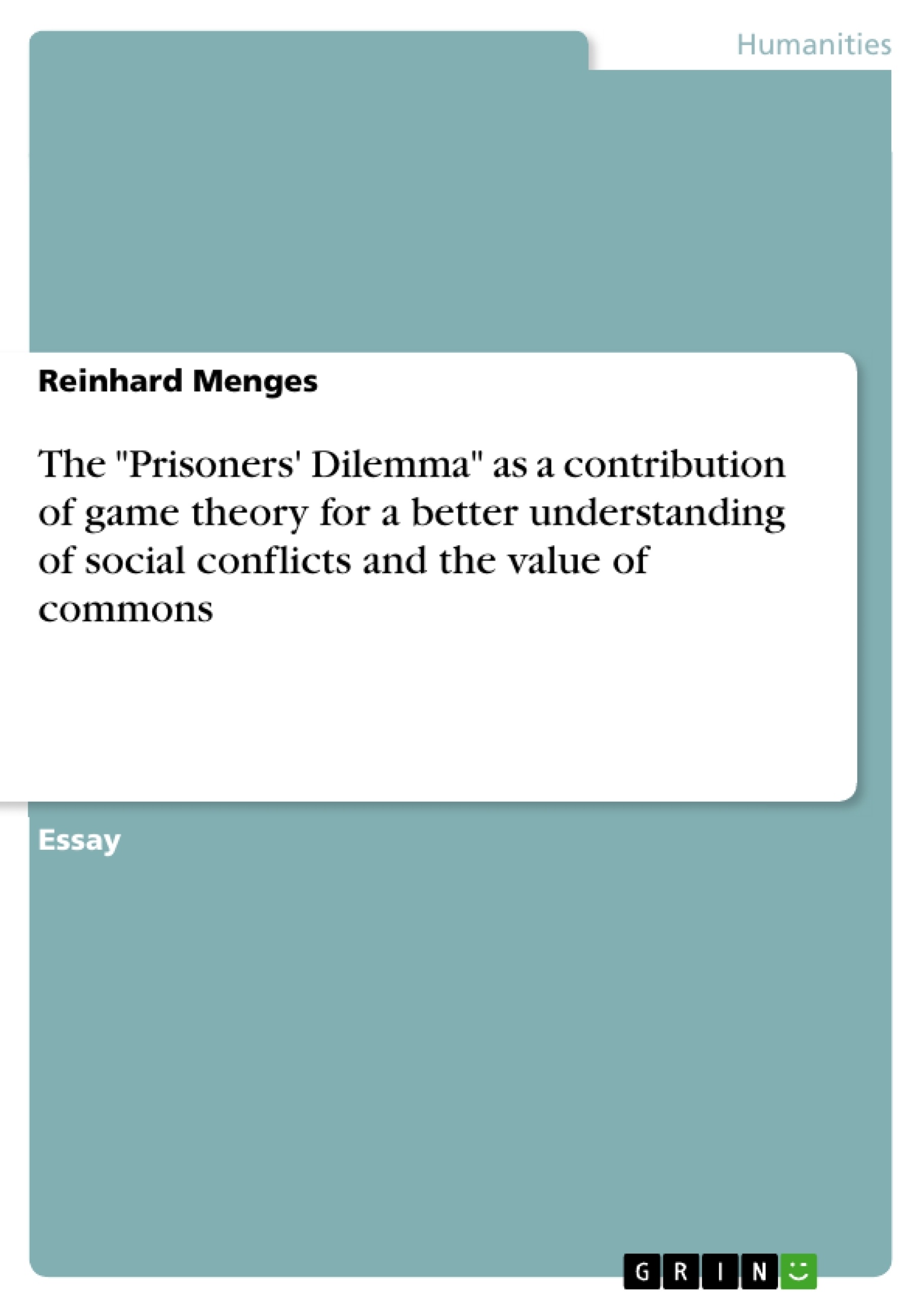The paper gives a detailed lecture on the prisoner's dilemma and emphasizes its application with regard to the development of common goods and values in social life. Whenever we make a rational choice which might inflict a loss or impose a risk on others we enter the world of morality. Trying to solve the conflict rationally between opposite moral positions we might find ourself in a "social dilemma". Such dilemma was basically modeled first in 1950 as the so-called "Prisoners' Dilemma" by canadian mathematician Albert Tucker and has been modified and developed since then in many ways, for instance by the nobel price winner Amartya Sen. Still today the basic model points out the permanent underlying conflict in our rationality respectively interest whenever it refers to the life of others, to the social life.
At a first glance the underlying story of the Prisoners' Dilemma "game" seems quite simple. Two criminals are held separately in prison being accused having committed one severe crime (let us say bank robbery) and another less severe crime (let us say fast driving). The judge talks to each of them separately in a way like this: "If you confess the severe crime and your complice does not than he will get the maximum penelty of 10 years in prison and you will be free, and vice versa. But if you both confess the severe crime then your confessions are not worth much so you will get the second highest penalty of 5 years. If you both don't confess but deny you both will get the third highest punishment of 3 years due to the undeniable less severe crime." There is no communication possible between the two prisoners.
Inhaltsverzeichnis (Table of Contents)
- The Prisoners' Dilemma
- The Model of Prisoners' Dilemma
- The Pay Off Panel
- The Game Matrix
- The "Private" Strategy
- Risk Management
- The "Maximin" Strategy
- Anonymous Groups versus Smaller Communities
- The "Saints' Dilemma"
Zielsetzung und Themenschwerpunkte (Objectives and Key Themes)
This essay explores the Prisoners' Dilemma, a foundational concept in game theory, and its relevance for understanding social conflicts and the creation of shared resources (commons). The author aims to analyze the model's structure and functions, demonstrate its applicability to real-world scenarios, and examine the interplay between rational self-interest and cooperation in shaping social outcomes.
- Rational Choice and Social Dilemmas
- The Importance of Cooperation and Commons
- The Role of Communication and Negotiation
- The Contrasting Strategies of "Private" Interest and Altruism
- The Application of the Model to Various Social Settings
Zusammenfassung der Kapitel (Chapter Summaries)
- The Prisoners' Dilemma: Introduces the concept of the Prisoners' Dilemma as a model of social conflict, highlighting its underlying logic and key elements.
- The Model of Prisoners' Dilemma: Examines the model's structure and functions, explaining its construction and the assumptions underlying it. It discusses the decision-making process of a rational actor within the context of the dilemma.
- The Pay Off Panel: Presents the payoff matrix and the possible outcomes for each prisoner based on their individual choices. It analyzes the preference order of outcomes from a "private" perspective.
- The Game Matrix: Introduces the matrix representation of the game, demonstrating the combination of decisions and their resulting outcomes for both prisoners.
- The "Private" Strategy: Discusses the rational choices a prisoner might make when prioritizing personal self-interest, considering the risks and potential payoffs associated with each option.
- Risk Management: Explores the importance of risk management within the decision-making process, considering the various possible outcomes and their associated probabilities.
- The "Maximin" Strategy: Analyzes the maximin strategy, which aims to minimize the worst possible outcome, and its implications for collective rationality.
- Anonymous Groups versus Smaller Communities: Examines the applicability of the Prisoners' Dilemma model to different social settings, highlighting the distinctions between anonymous groups and smaller communities in terms of communication and trust.
- The "Saints' Dilemma": Introduces the concept of the "Saints' Dilemma" as a variant of the Prisoners' Dilemma, focusing on the dilemmas arising from altruistic behavior.
Schlüsselwörter (Keywords)
The key terms and concepts explored in this text include: Prisoners' Dilemma, game theory, social conflicts, commons, rationality, cooperation, altruism, self-interest, communication, negotiation, risk management, maximin strategy, anonymous groups, smaller communities, social dilemmas, and moral positions.
- Citation du texte
- Reinhard Menges (Auteur), 2014, The "Prisoners' Dilemma" as a contribution of game theory for a better understanding of social conflicts and the value of commons, Munich, GRIN Verlag, https://www.grin.com/document/476865



